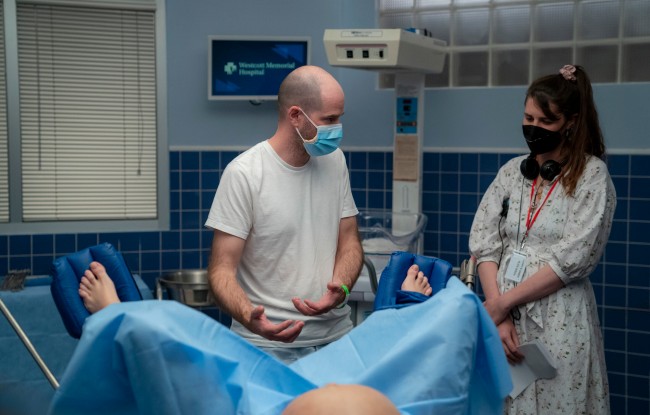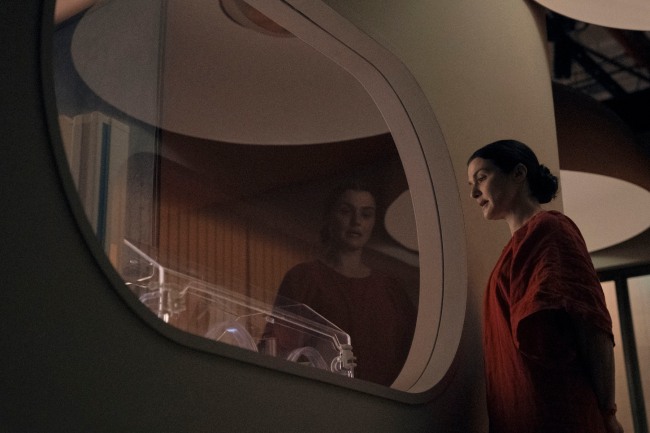
It’s hard to talk about “Dead Ringers” and not start with the lamb wall. One of the most striking images in the entire six-episode Prime Video adaptation is Elliot Mantle (Rachel Weisz) standing in front of a display of lamb fetuses in different stages of gestation. In order to fully feel the effects of the meticulous work that the Mantles do to push the boundaries of science, the show’s production team put in plenty of their own (far more legally and ethically acceptable) work.
For series prop master Patrick Head, that meant working to help make something that would fit with the aesthetics of the show that showrunner Alice Birch had set out, and would also seem functional for Elliot’s purpose inside the story.
“We presented to Alice the prototype, which is very similar to research that they’re doing in Philadelphia right now. We were going to present various stages, the scientific version of DIY,” Head said. “The next version would be a lot more clean-looking. Then we would dispense with sort of the functionality of it and just have like a very impressive display. So we had these lambs made at various ages. Some of them just were static props, and some of them were puppets that can be manipulated so their legs moved. It ended up being the simplest, cleanest presentation in these glass boxes, and then they’re floating in, you know, goo.”
Before dealing with the eventual realities of four-legged puppets, one of the biggest challenges came at the beginning of production, with a scene depicting an emergency C-section. It was just one example of the production team working with OB-GYN consultants to make sure that the tools and techniques involved were accurate and used properly. That also went for the quick succession of births in the first “Dead Ringers” episode, which laid the groundwork for Head’s interactions with the LA-based effects house Autonomous FX, which built the prosthetic babies that allowed the series to film those intense delivery room scenes as practically as possible.
“The birthing montage was something that they wanted to portray very viscerally and accurately. I had access to a lot of photographers who accompany people when they’re giving birth. I pulled a lot of images of the freshest of newborns, and all the different colors they come in and the weird head shapes. We identified some of the details that we wanted to depict. Early on, I knew I was gonna need a lot of fake babies,” Head said. “We were telling Autonomous, ‘We want one baby that’s kind of bluish, and one that’s got a smushed-up head,’ all this stuff. They did a standing birth for another show. So they sent me over a picture of a prosthetic rig that they built already, which was essentially a belly, an anatomically correct vagina, and legs. It’s hollow, so that they can put the baby in the top and push it on through. That went over well, and we had them build several more of them in in different skin tones. And that was all for the first week of shooting.”
For days like one of the C-section shoots, the intricate setup required everything from silicone umbilical cords to a massive two-step process elsewhere.

“The C-section had some moving parts. That was another piece they built for us where they could fit the baby inside of the belly. There was one piece just for the incision, where the scalpel cut the silicone skin and there’s a little bit of blood underneath that would then leak out. Then they had a separate section where the incision and already been cut, and then you have all the different layers of subcutaneous fat, a uterus that you could cut open. And then inside of that was the baby attached to an umbilical cord attached to a placenta. They could do their hand movements and eventually scoop the baby out.”
With that intricate choreography of silicone happening in this birthing center, there was one surprisingly practical part of the shoot’s demands that proved to be as tricky as the elaborate setups: having enough supplies.
“Doing take after take, we needed fresh gloves, the paper for the table, and everything. Once it gets messy, then you switch everything out again. So we were just blowing through all these different surgical drapes and PPE. That was something that was kind of nerve-racking, I guess, ‘Are we have enough of this very specific kind of surgery drape?'” Head said. “And then of course, whenever you’re working with actors who are not doctors, you’ve got to get them to a point where they feel comfortable doing the motions as if they’re been doing it forever. And this was another instance where we would bring in actual OB-GYN surgical techs, and use them as hand doubles so that you could work very quickly and assuredly, to get all those steps done right.”
While these prosthetic babies do need to look realistic, there’s also plenty of attention paid to how much they weigh. For scenes where Weisz has to move around with (at least) one cradled in her arms, it helps the illusion that the model has the same heft and can’t just be flung around.
“When you hold a living thing, a precious newborn, you treat it with the utmost of care. Every single motion is considerate, and you have to support the head. You want to build that into the prosthetic or the prop, so that when the actors are handling it, they have that same sense of care and consideration with this piece of silicone which, as it turns out, weighs about the same and is kind of floppy,” Head said.
Those babies represented not only a budgetary investment for the props department but a time one as well. For every baby that came to life within the context of the show, that also represented a lengthy process for making sure that the performers playing the pregnant mothers also fit seamlessly into the fabric of “Dead Ringers.”

“Dead Ringers”Niko Tavernise/Prime Video
“The timeframe for making the work is a lot longer than what you usually have with television. We would have to cast some of these mothers very early in the process, much earlier than they would otherwise. That way, they could do a mold of their body and match their skin tone and all these other things that need weeks and weeks to play out,” Head said.
One other distinct challenge for “Dead Ringers” is that some sequences switched back and forth between models and the actual live babies they’re modeled after. Monitoring that process and making sure everyone remained safe — particularly filming during a time where Covid considerations were still very much at the forefront — added to the list of considerations for the crew.
“Any time you have an infant, you bring a nurse in. We work with the nurse and the costume department to swaddle the baby properly in the blanket and the hat or whatever else we want to appear on screen. We work with a professionals to make sure that we’re not going to do anything that causes the babies to have an adverse reaction or to stress them out too much. No one wants a crying baby,” Head said. “If we’re gonna do any kind of gunk on them, we have to run that by the nurse and the parents. We bought a thick baby lotion to replicate the vernix, the protective coating that’s on the skin of the babies when they’re first born. You’re not really supposed to wipe that off because it has nutrients, but that’s why they look like they’ve been smeared in something white.”
While birth is really the star of the show, don’t sleep on the food. It’s the slicing into poultry that in some ways sets up the visceral sequences with the scalpel. Head also pointed out that food plays a key part in tracking the thematic evolution of the season.
“Each episode had a fruit theme that corresponded to the development of a fetus. We started with cherries, and then we moved to limes. Grapefruit was for the episode when they’re in Alabama, and then we ended on watermelon. If you watch carefully, there’s a pomegranate that’s in there, too, when the parents were visiting,” Head said.
That, in turn, made for an incredible parting gift for the “Dead Ringers” cast and crew.
“For wrap, I made these little goodie bags with fake placenta and fake umbilical cords and put them in a biohazard specimen bag. Dehydrated watermelon was the placenta, and then some red licorice. It was a hit,” Head said.
“Dead Ringers” is now available to stream on Prime Video.


